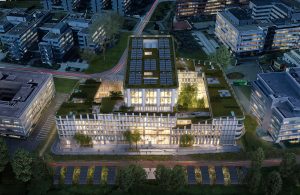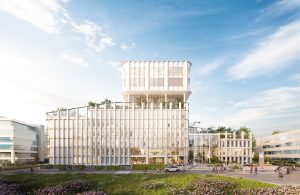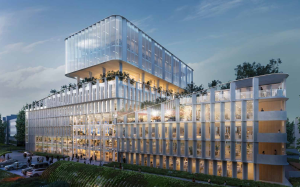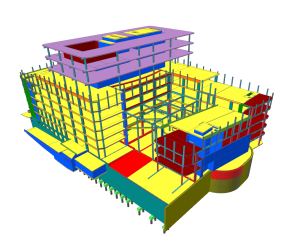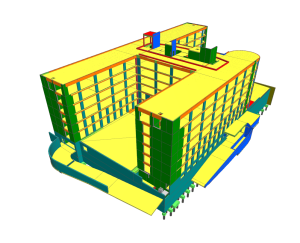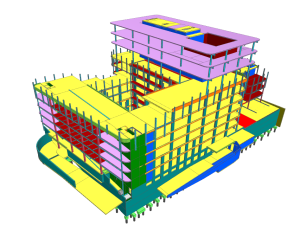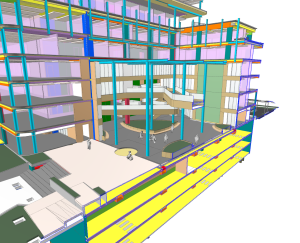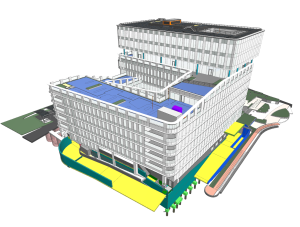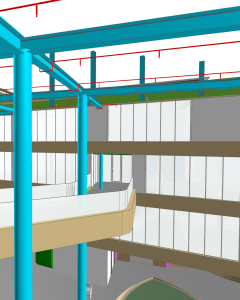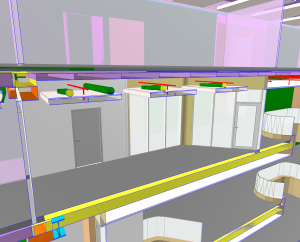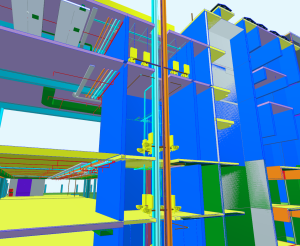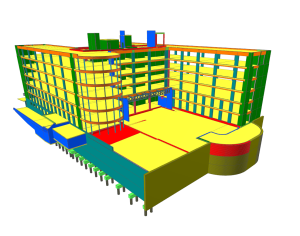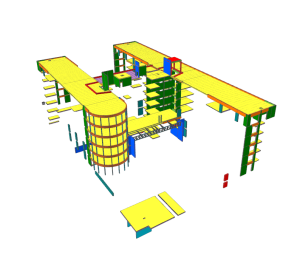YPSO

| Kategoria | Projekty komercyjne |
|---|---|
| Rok | 2024 |
| Kraj | Benelux |
| Organizacja | Macobo-stabo |
| Partnerzy projektu | Jaspers-Eyers Architects |
| Autor | Macobo-stabo |
| Klient | Eaglestone Belgium |
| Miejsce budowy | Diegem |
| Tags | ConcreteTekla StructuresTimberSteel |
Ypso in Diegem is een uniek renovatieproject geïnitieerd door Eaglestone Belgium waarbij het gebouw wordt omgevormd tot een kwalitatief hoogstaand kantorencomplex. Er worden vier extra verdiepingen gebouwd en bijkomende vleugels, goed voor een toegevoegde oppervlakte van 4.300 m². Na de renovatie zal het gebouw acht bovengrondse en drie ondergrondse verdiepingen tellen met een totale oppervlakte van 38.000 m². Door de renovatie zal het gebouw voldoen aan de nieuwste normen inzake duurzaamheid en energieprestaties waardoor het CO2 neutraal en BREEAM Outstanding gecertificeerd zal worden.
Bij de uitwerking van het stabiliteitstechnisch concept van het gebouw, werd er gestreefd om zo veel mogelijk van de bestaande structuur te bewaren. Dit niet enkel uit economisch standpunt, maar ook vanuit een duurzame benadering. De embodied carbon van het bestaande gebouw blijft zo immers maximaal benut. Om de impact op de fundering te beperken en de bruikbaarheid en de kostprijs van het gebouw te optimaliseren, wordt er gewerkt met een hybride structuur. Staal, beton en hout worden op een logische en efficiënte manier gecombineerd om een flexibele indeling te bewaren.
Een 3D-weergave van het structuurmodel werd opgebouwd in Tekla Structures. In eerste instantie werd de bestaande structuur volledig overgenomen op basis van de originele uitvoeringsplannen waardoor een digital twin van de draagstructuur van het gebouw werd gecreëerd. Het detaillniveau voor de welfsels werd hierbij opgedreven zodat elk afzonderlijk welfsel waarneembaar is in het 3D model. Ook de bekistingselementen van de holle wanden werden per paneel en met hun schillen volledig afgestemd op de werkelijkheid. Vervolgens werd de af te breken structuur gedefinieerd en de nieuwe structuurelementen ingetekend. Dankzij filtering op basis van gecreëerde fases en een parameter ‘Renovatiestatus’, kunnen de bestaande, nieuwe en af te breken gebouwonderdelen in het model worden onderscheiden.
Tijdens het ontwerpproces werd er erg ingezet op BIM. Iedere projectpartner genereerde uit zijn eigen native software IFC-modellen, die als basis werden gebruikt voor de coördinatie tussen de verschillende disciplines in open BIM. Op deze manier kon de klant steeds meekijken in het project en konden pijnpunten meteen worden aangepakt. Het structuurmodel en het architectuurmodel voor de nieuw te bouwen structuur werd nauwgezet op elkaar afgestemd totdat vorm en functie een mooie eenheid vormden. Studiebureau Macobo-stabo beheerst zowel de disciplines stabiliteit, gebouwentechnieken, akoestiek als duurzaamheid en mag voor Ypso voor al deze vakgebieden een studie uitvoeren. Hoewel de coördinatie hier dus volledig intern verloopt, wordt er niet afgeweken van de open BIM standaard.
Renders ©Eaglestone Belgium
Ypso in Diegem is a unique renovation project initiated by Eaglestone Belgium in which the building will be transformed to a high-quality office complex. Four additional floors and additional wings will be built, accounting for an added area of 4,300 m². After the renovation, the building will have eight above-ground and three underground storeys with a total area of 38,000 m². The renovation will ensure the building to the latest sustainability and energy performance standards, making it CO2 neutral and BREEAM Outstanding certified.
The aim during the elaboration of the building’s construction engineering concept, was to preserve as much of the existing structure as possible. Not only out of an economic point of view, but also for a sustainable approach. After all, there is a maximum benefit of the embodied carbon of the existing building. To limit the impact on the foundation and optimise the usability and cost price of the building, a hybrid structure is used. Steel, concrete and wood are combined in a logical and efficient way to preserve a flexible layout.
A 3D representation of the structural model was built in Tekla Structures. Initially, the existing structure was completely reproduced based on the original execution plans. In this way, a digital twin of the building’s supporting structure was created. The level of detail of the floor slabs was increased so each individual slab is visible in the 3D model. By splitting the hollow walls in panels, these elements were also fully aligned with reality. Subsequently, the structure to be demolished was defined and the new structural elements were drawn in. Thanks to filtering based on created phases and a 'Renovatiestatus’ parameter, the existing, the new and the building elements to be demolished could be distinguished in the model.
During the design process, BIM was very much used. Each project partner generated IFC models from its own native software, which served as the basis for coordination between the various disciplines in open BIM. In this way, the client could always keep an eye on the project and pain points could be addressed immediately. The structural model and the architectural model were meticulously coordinated for the newly built structure until form and function formed a beautiful unity. Engineering company Macobo-stabo has mastered the disciplines of stability, building technology, acoustics and sustainability, and was allowed to execute a study for Ypso for all these disciplines. Although coordination is therefore entirely internal, there is no deviation from the open BIM standard.
